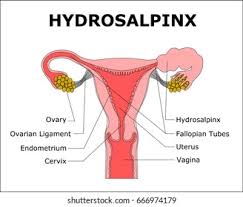 A hydrosalpinx occurs when a Fallopian tube is blocked and fills with serous or clear fluid near the ovary.
A hydrosalpinx occurs when a Fallopian tube is blocked and fills with serous or clear fluid near the ovary.
A blocked Fallopian tube may become distended giving the tube a characteristic sausage-like shape, and may reach several centimeters in diameter.
The condition is often bilateral.
Blocked tubes cause infertility.
A Fallopian tube filled with blood is a hematosalpinx, and one with pus a pyosalpinx.
Symptoms vary: lower, often, recurring abdominal pain or pelvic pain, while others may be asymptomatic.
As tubal function is impeded, infertility is a common symptom.
Endometriosis, ruptured appendicitis, and abdominal surgery sometimes are associated problems.
With injury, the body adds inflammatory cells to the area.
The inflammation and later healing result in loss of the fimbria and closure of the tube.
These infections usually affect both Fallopian tubes.
A hydrosalpinx can be one-sided, but the other tube is often abnormal.
The tubal fluid usually is sterile by the time the process is identified.
The most common cause for distal tubal occlusion is pelvic inflammatory disease.
It is usually as a consequence of an ascending infection: chlamydia or gonorrhea.
Not all pelvic infections will cause distal tubal occlusion.
Fallopian tube fluid is normally discharged via the fimbriated end into the peritoneal cavity.
If the fimbriated end of the tube becomes obstructed and does not allow the tubal fluid to pass, it will accumulate and revert its flow downstream, into the uterus, or its production is curtailed by damage to the endosalpinx.
As a result sperm cannot pass, the egg is not picked up, and fertilization does not take place.
Other causes of distal tubal occlusion include adhesion formation from surgery, endometriosis, and cancer of the tube, ovary or other surrounding organs.
A hematosalpinx is most commonly associated with an ectopic pregnancy.
A pyosalpinx is typically seen in a more acute stage of pelvic inflammatory disease and may be part of a tubo-ovarian abscess.
Tubal phimosis refers to partially occluded tube, impeding fertility and the risk of an ectopic pregnancy is increased.
Diagnosis:
Hydrosalpinx diagnosis is by identification via ultrasonography as the fluid filled elongated and distended tubes display their typical echolucent pattern.
A small hydrosalpinx may be missed by sonography, and a hysterosalpingogram, using a contrast agent to image the Fallopian tubes, can identify the retort-like shape of the distended tubes and the absence of spillage of the dye into the peritoneum.
Laparoscopy allows for the diagnosis of hydrosalpinx, but also allows intervention.
Reducing sexually transmitted diseases will reduce incidence of hydrosalpinx.
Hdrosalpinx is a complication to a pelvic infection, and adequate and early antibiotic treatment of a pelvic infection is required to prevent this.
Management:
Historically with tubal infertility due to hydrosalpinx patients undergo tubal correction surgery to open the distal occluded end of the tube and remove adhesions: Pregnancy rates however are quite low as the infection often permanently damages the tube.
Ectopic pregnancy risk increases as a possible complication of tubal surgery.
Surgical interventions can be done by laparoscopic surgery.
For patients who suffer from severe chronic pain due to hydrosalpinx not relieved by pain management may consider surgical removal of the affected tubes or even a hysterectomy with removal of the tubes, possibly ovaries.
Among the main causes for female infertility, tubal factors account for 25-35% of cases.
Hydrosalpinx is found in 10-30% of couples with infertility.
Hydrosalpinx may impair fertility and IVF outcomes, as well.
IVF is the major treatment for women with hydrosalpinx to achieve a pregnancy.
It is speculated that the tubal fluid that enters the endometrial cavity alters the local environment or affects the embryo in a detrimental way.
The presence of hydrosalpinx prior to IVF treatments, negatively affects pregnancy rates and increases the risk for spontaneous miscarriage.
Some advocate that prior to an IVF attempt, the hydrosalpinx should be removed.
Salpingectomy removes the chronically infected hydrosalpinx, decreasing the risk of infection after oocyte retrieval and increasing the accessibility to the ovary
